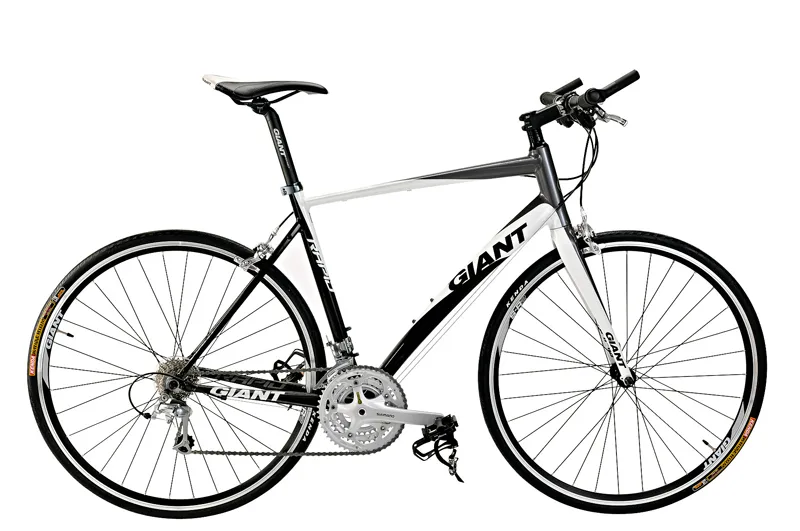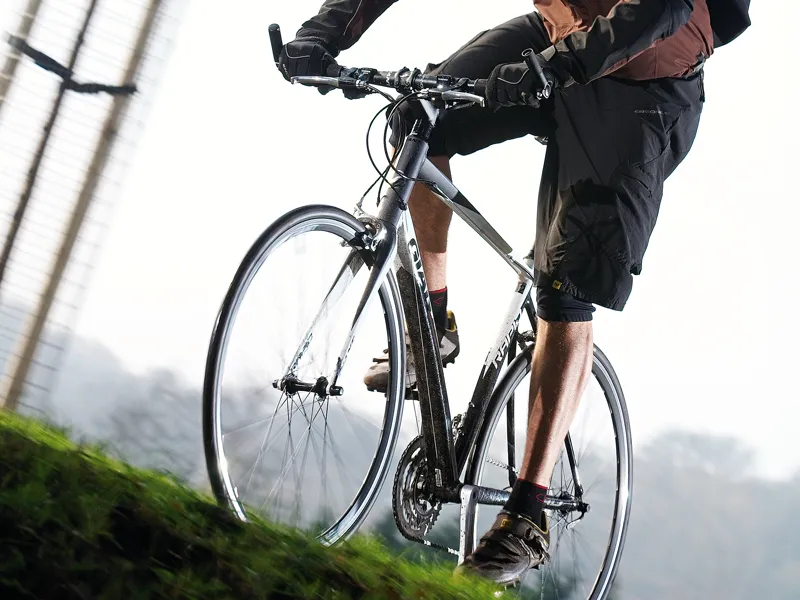The Rapid 2 might look a lot like a Giant Defy road bike with a flat handlebar stuck on it, but there's much more to the company's fast-commute and fitness bike than that. If you want a light, fast, narrow-tyred bike and don't like drop bars, it should be on your shortlist.
Unlike some flat-bar road options, it has the clearances and frame eyelets you need to fit mudguards and a rack, making it a practical proposition for burning it up on the way to work. It lacks the versatility of some other hybrids and doesn't have the longer-ride comfort of a similarly priced sportive bike, but what it does, it does well.
- Frame: Sporty feeling and road-bike light. It’s designed for 57mm-drop brakes so ample room for mudguards with 25mm or narrower tyres (8/10)
- Handling: It’s a road bike with more steering leverage so has sharp reactions and good acceleration. Nippy as a naughty cycle courier around town, it’s a bit bruising for long rides. Stronger riders may appreciate the tighter rear triangle and oversized seatpost (7/10)
- Equipment: A road triple allows a constant cadence across variety of terrain, though the cassette could go bigger for heavier riders or hills. Nice to get bar ends (7/10)
- Wheels: Training tyres on training-grade wheels. The hoops are okay but you’ll want to upgrade the rubber for something that rolls well but is tougher (6/10)

The Rapid's aluminium frame follows the compact design pioneered by Giant on the road, the top tube dropping steeply to the seat tube to create a tighter triangle for improved strength and stiffness with no weight penalty. The rear triangle is compact too, with short, braceless chainstays and skinny seatstays that join the seat tube lower down.
As on the similar looking Defy bikes, tube profiles flare wider at the head tube and flatten towards the seat tube, and the Rapid gets a straight-bladed carbon fibre fork with aluminium steerer. Differences from the Defy are subtle. The effective top tube is longer to accommodate a flat bar without compromising the more stretched out reach you want for athletic riding. And clearances are bigger under the frame and fork.
The Rapid 2 has been built to accept mid-drop brakes – just like the Defy’s forerunner, the SCR, but unlike the short-drop Defy. So the Rapid’s mudguard eyelets aren’t token additions: you can safely fit full-length muck stoppers above its 25mm tyres. There are eyelets on the seatstays too, for fitting a rear carrier. Small panniers or a racktop bag would be best for heel clearance, given the Rapid’s short chainstays.
The omission of the chainstay brace means that clearances aren’t fag-paper thin, although this does remove the obvious lower mounting point for a rear mudguard; you get a boss on the seat tube instead. You don’t need a chainstay brace, for structural reasons, and there’s no detectable loss of stiffness in the Rapid’s rear triangle. If anything it’s stiffer due to those shorter stays.
The seatpost is slightly oversized too, and combined with the Rapid’s narrow tyres you end up feeling the road through the back end of the bike more than you do on most hybrids. It’s not especially uncomfortable unless you sit upright with almost all of your weight on the saddle. Giant isn’t kidding when they say it’s like a road bike. You need to ride it like one, leaning forward so your weight is divided between saddle and bar.
The reach is roomy enough for this but if you’re borderline between bike sizes it’s better to go for the large. We upsized to the M/L from the M and were glad we did. Given that you’ll be riding this bike with some weight on your hands, it’s good that Giant have supplied bar ends. Being able to vary your hand position will help keep pins and needles at bay and give alternative grips for climbing or hacking into headwinds.
There’s still a fair bit of road feedback – this is no drop-bar sportive bike – so the Rapid better suits short to medium rides than all-day epics. It’s fine for an hour or two’s fitness training in the lanes, and excels at sprinting across town, where the road bike feel and tightly reined steering flatters a cut-and-thrust approach to commuting.
The nine-speed drivetrain is all road based, albeit with flat-bar controls. The 50/39/30T chainset isn’t as neat or light a setup as a compact double, but it does give closer, cadence-cosseting steps between front shifts. The range isn't particularly wide so if you’re planning to cycle with luggage or are coming back after a long layoff you may struggle a bit on hills. But for winding up the pace on the way to work or unladen fitness riding it’s a decent overall spread.
Sidepull brakes require less cable pull than V-brakes or cantilevers, but these work fine with the flat-bar road levers. The only early upgrade we’d make would be the tyres: Kenda Kriteriums roll okay but on streets sprinkled with crumbs of glass you want something tougher – Panaracer’s Stradius Sport TGs are good for the money, and Michelin’s Krylion Carbons better overall.

